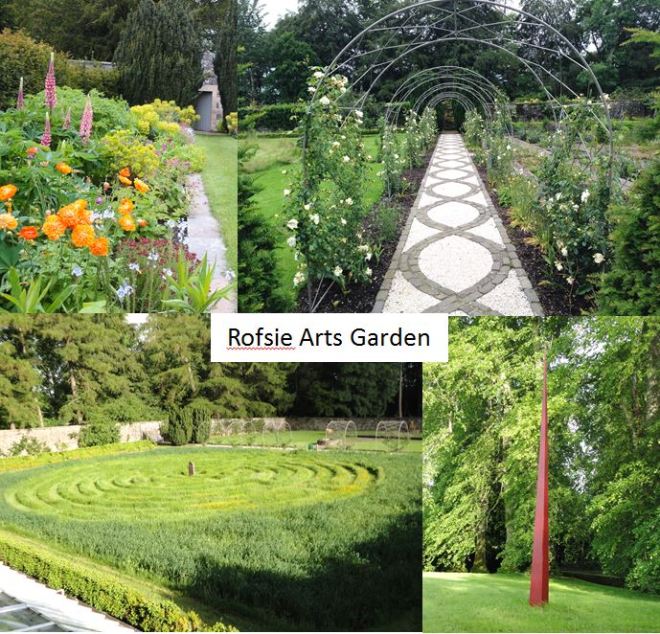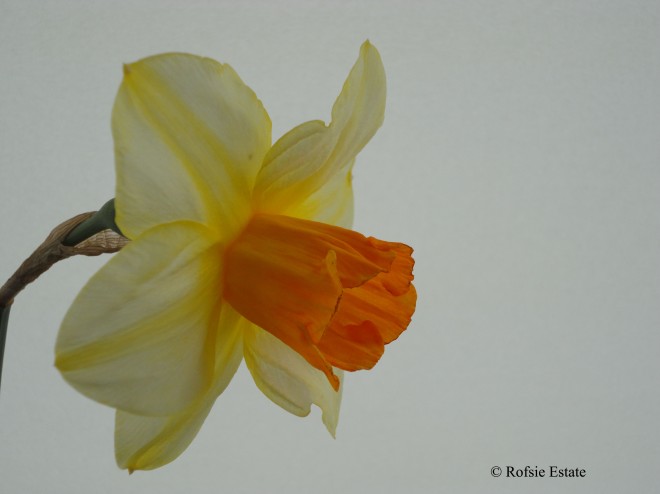A few months ago, we received an email at Plinth et al. from a woman named Caroline, who was seeking information or help regarding certain Narcissi. In doing our best to help, we asked that she elaborate on her story so it could be shared with our readers and others, with the goal of helping Caroline in her search for her family’s bulbs. We ask that after reading this, to kindly share this incredible story with others, through email or other social media outlets to help Caroline and the Backhouse family find the bulbs that are missing from their collection. Thank you so much for your help. – James
 Through my mother’s line I am a direct descendent of the Backhouse family, well known horticulturists and daffodil breeders. During the garden replanting and renovation work, my mother suggested it would be a good idea for a member of the family to collect together the remaining Backhouse-bred or introduced plants and bulbs before they are lost to time. My husband and I seem to have entered into a lifetime commitment to the Backhouse daffodils and plants which to date has been demanding and hard work but is certainly the loveliest, most uplifting and exciting project to be engaged in. We are sending this ‘call out’ to anyone who has or knows of a named Backhouse daffodil or plant which they would either photograph and send for our reference material or donate or sell one or two bulbs to the Backhouse Heritage Daffodil Collection in Fife, Scotland. If you are a commercial nursery or horticultural institution with a shipping license. I can send a list of ‘most wanted’ cultivar names, which are also on our web site. We are in the process of seeking National Collection Status for the daffodils. We are not for profit for this is a true labour of love!
Through my mother’s line I am a direct descendent of the Backhouse family, well known horticulturists and daffodil breeders. During the garden replanting and renovation work, my mother suggested it would be a good idea for a member of the family to collect together the remaining Backhouse-bred or introduced plants and bulbs before they are lost to time. My husband and I seem to have entered into a lifetime commitment to the Backhouse daffodils and plants which to date has been demanding and hard work but is certainly the loveliest, most uplifting and exciting project to be engaged in. We are sending this ‘call out’ to anyone who has or knows of a named Backhouse daffodil or plant which they would either photograph and send for our reference material or donate or sell one or two bulbs to the Backhouse Heritage Daffodil Collection in Fife, Scotland. If you are a commercial nursery or horticultural institution with a shipping license. I can send a list of ‘most wanted’ cultivar names, which are also on our web site. We are in the process of seeking National Collection Status for the daffodils. We are not for profit for this is a true labour of love!

We are grateful for the invaluable help we have already received in the ongoing process of gathering together bulbs and images for identification of the Backhouse Daffodils from members of our family, RHS Library at Vincent Square London and the former Daffodil Registrar Sally Kington, RHS Wisley, members of the UK Daffodil Society, Dr David Willis, Jan Dalton, Kew Gardens Archive Library, the American Daffodil Society, and Lynn Batdorf.
Six years of hard but very enjoyable work has gone by in the restoration of the garden, now a beautiful collection of Backhouse Heritage Daffodil cultivars that greet visitors to Rofsie Arts Garden in Spring. They are preceded by Galanthus ‘James Backhouse’, G. ‘Alison Hilary’ and G. ‘Mrs Backhouse Spectacles’. Erica carnea ‘James Backhouse’ flowers on Monastery walk beside the walled garden. Later in the year Lavandula angustifolia ‘James Backhouse’, Correa backhouseana or Backhouse Australian fuchsia along with tree ferns and other plants which were for sale at the Backhouse Nursery during their heyday in the 1800s, growing happily in the garden and glass house.

Backhouse Daffodils changed daffodil breeding forever – William Backhouse, the first of the daffodil breeding dynasty, whose great achievement was breeding the stately Narcissus ‘Emperor’ and the bicoloured N.‘Empress’ in 1865. These cultivars are two of the first triploid bulbs to be raised by a daffodil breeder; although Backhouse would not have known about the word chromosome, he had succeeded in increasing the chromosome count from diploid (14 chromosomes) to triploid (21 chromosomes). Modern daffodils with lineage of these two daffodils in their breeding still dominate divisions 1 and 2 and are still strongly present in division 3 of the RHS Daffodil Register. There has long been a debate about these two daffodils’ parentage—indeed there is a letter from Copeland to Mrs. RO Backhouse asking her as to the parentage, however it is generally accepted that James Backhouse a well-known horticulturist and Williams first cousin’s account in the Garden Magazine is correct – the parentage is believed to be Narcissus pseudonarcissus and Narcissus bicolor. However William Backhouse’s great legacy was to create the first known tetraploid cultivar N.’Weardale Perfection’. At its peak ‘Weardale Perfection’ was the clear leader amongst daffodils for its huge bi-coloured flower more than five inches in diameter and its stem at least two foot tall, and was in the greatest demand at the time. Nearly all modern cultivars are tetraploid because they are healthy and strong and the possibilities of which the genes can sit on the chromosomes are vast and varied. ‘Weardale Perfection’ has long been superseded by its grandchildren and great grandchildren but such is the enduring appeal of Narcissus ‘Weardale Perfection’ and triploids N.‘Emperor’ and N.‘Empress’ still in commerce today. William’s son RO Backhouse continued in the family tradition breeding hundreds of seedlings, perhaps his best known being N.‘Backhouses Giant’ and one of his most lovely N.’Lune de Miel’, his wife Sarah Elizabeth Dodgson was a very able daffodil breeder, Engleheart himself a giant in the daffodil world wrote it was possible for people to discern in her work “the vast difference between talent and genius”. Sarah achieved national fame being awarded the Royal Horticultural Society’s Barr Cup in 1916, and in 1923 Robert astounded the horticultural world with the first pink daffodil which he named ‘Mrs. R. 0. Backhouse’. Robert and Sarah’s son, William Ormiston Backhouse continued the family tradition set by his grandfather. He specialized in red-trumpeted daffodils one of his most notable achievements being ’Brer Fox’, a Division 1 red trumpet.
We believe it’s important to find and save these lovely flowers. Our search for the lost daffodil cultivars has involved driving literally thousands of miles at springtime, making maps of sites we have taken daffodils from (always with permission) on many occasions in sleet, rain and wind which has almost taken me off my feet! There are over 27,000 daffodil cultivars registered in the RHS Daffodil Register, making identification of historic varieties uncommon in commerce today very difficult. We have been particularly lucky in this task for two reasons. Firstly we are not for profit, we are doing this to create a living library of daffodils to save the genetic heritage and achievements of three generations of Backhouse daffodil breeders’ groundbreaking work for posterity. Happily we have found people who want to help with this labour of love in identification. Secondly the older generation in the families can still remember the names of some daffodils, what the flowers looked like and which gardens the plants might still be growing . On occasion they still live in the same family homes and know which daffodils are growing in the garden. We have learnt a lot about the family during this process as often a great aunt or uncle tells us why the daffodil name is of personal significance whether it is named after them or a special place, person or event or family achievement.. When this aural history matches the images we have and the daffodil description in the register it gives us added surety of the cultivar names, we have amassed many pictures with the help of the archives, organizations and people aforementioned from contemporary bulb catalogues or images from horticultural magazines, photographs taken by family and contemporaneous paintings which have proved invaluable in this task. Each year, the daffodil collection is growing. There is a buzz of excitement in the air as spring brings the blooms, and we hope to be able to find some of the missing ones or gain images so we can identify the nameless Backhouse daffodils.

If you know of a named Backhouse Daffodil Cultivar in a collection and can spare a bulb or two for the Backhouse Collection of Daffodils or have a Backhouse Daffodil photo we would very much like to hear from you. Donations of bulbs or visual material are commemorated, but we will also respect your wish to remain anonymous.
Please contact Caroline via the web site www.rofsie-estate.com if you would like to support the Backhouse Heritage Daffodil Collection
Artists call for submissions – Rofsie Arts Garden in Fife Scotland is hosting its second annual Art Exhibition – the theme this year is ‘A Response to Gardens and Gardening’ and the exhibition will run throughout July. If you are an artist interested in showing your work in this unique and beautiful space, with a characterful vernacular building also available for indoor exhibition space, please send images of your work and a CV to our web site email address below. Deadline for submission of images May 20th. We only take a small commission – enough to cover exhibition costs but you will be responsible for insurance transportation and return of any unsold work.(we can carefully repack unsold work in its original packing for uplift) If you have any further questions please contact Caroline via the web site.
Contact details for Caroline via the web site www.rofsie-estate.com

